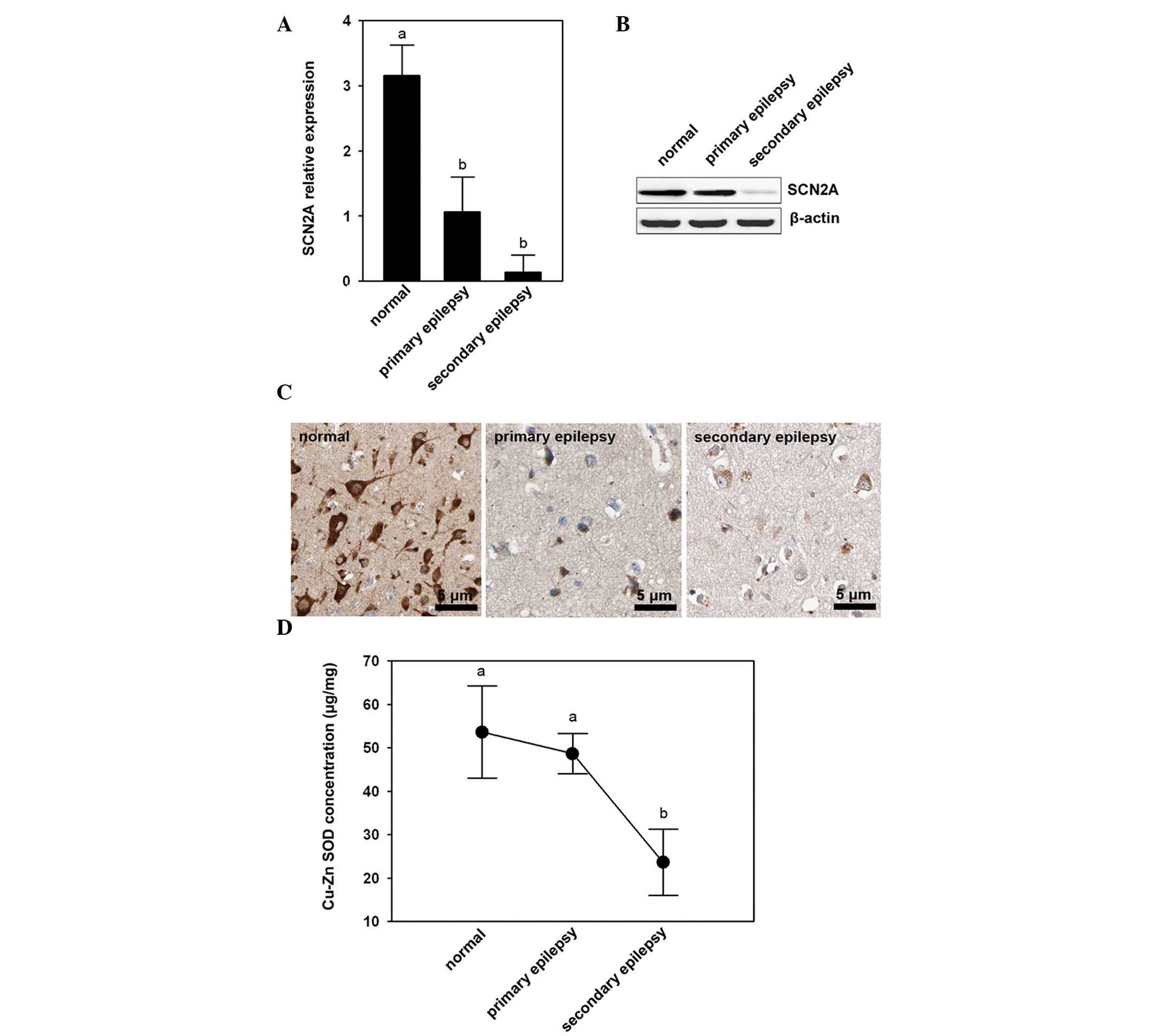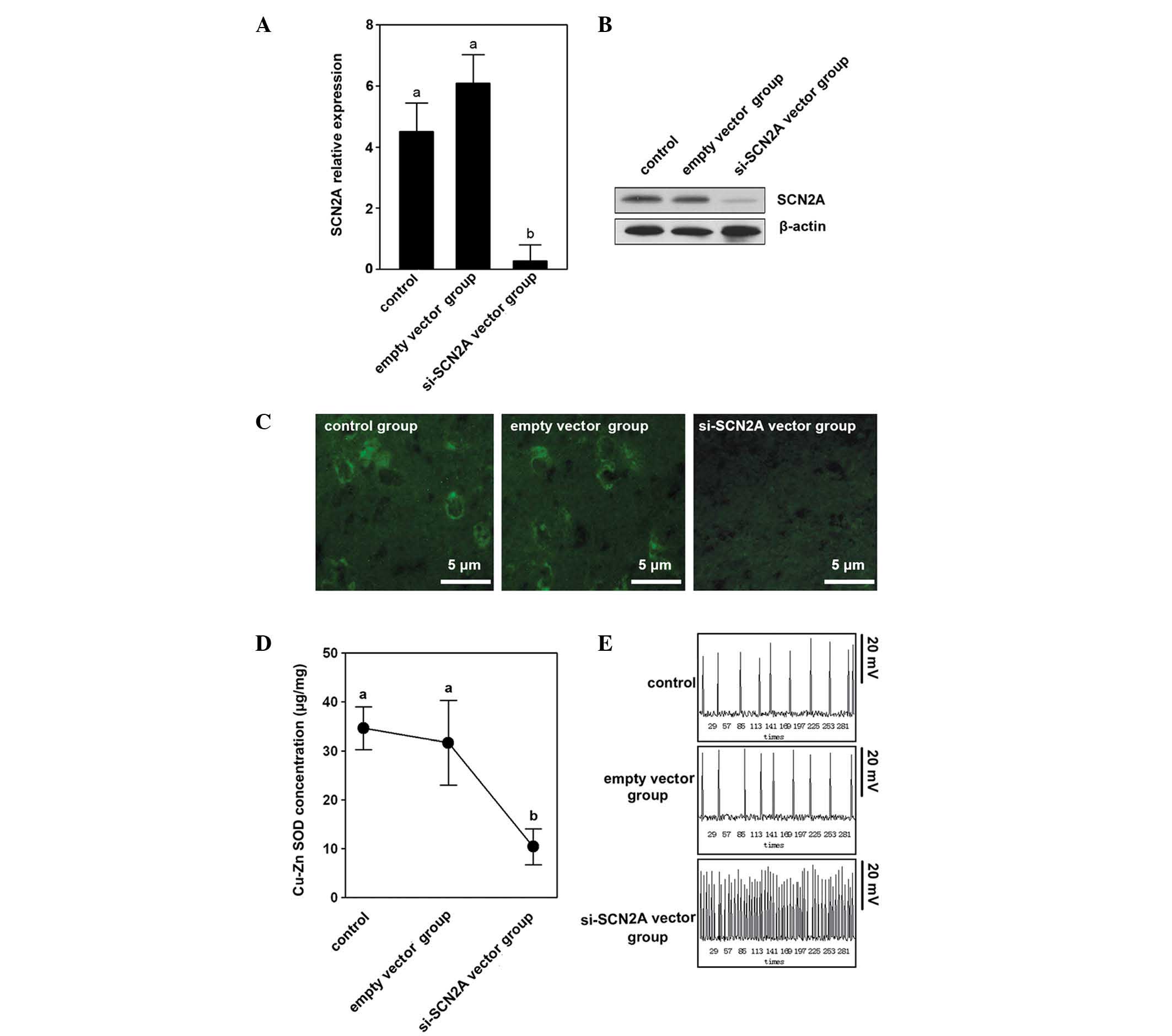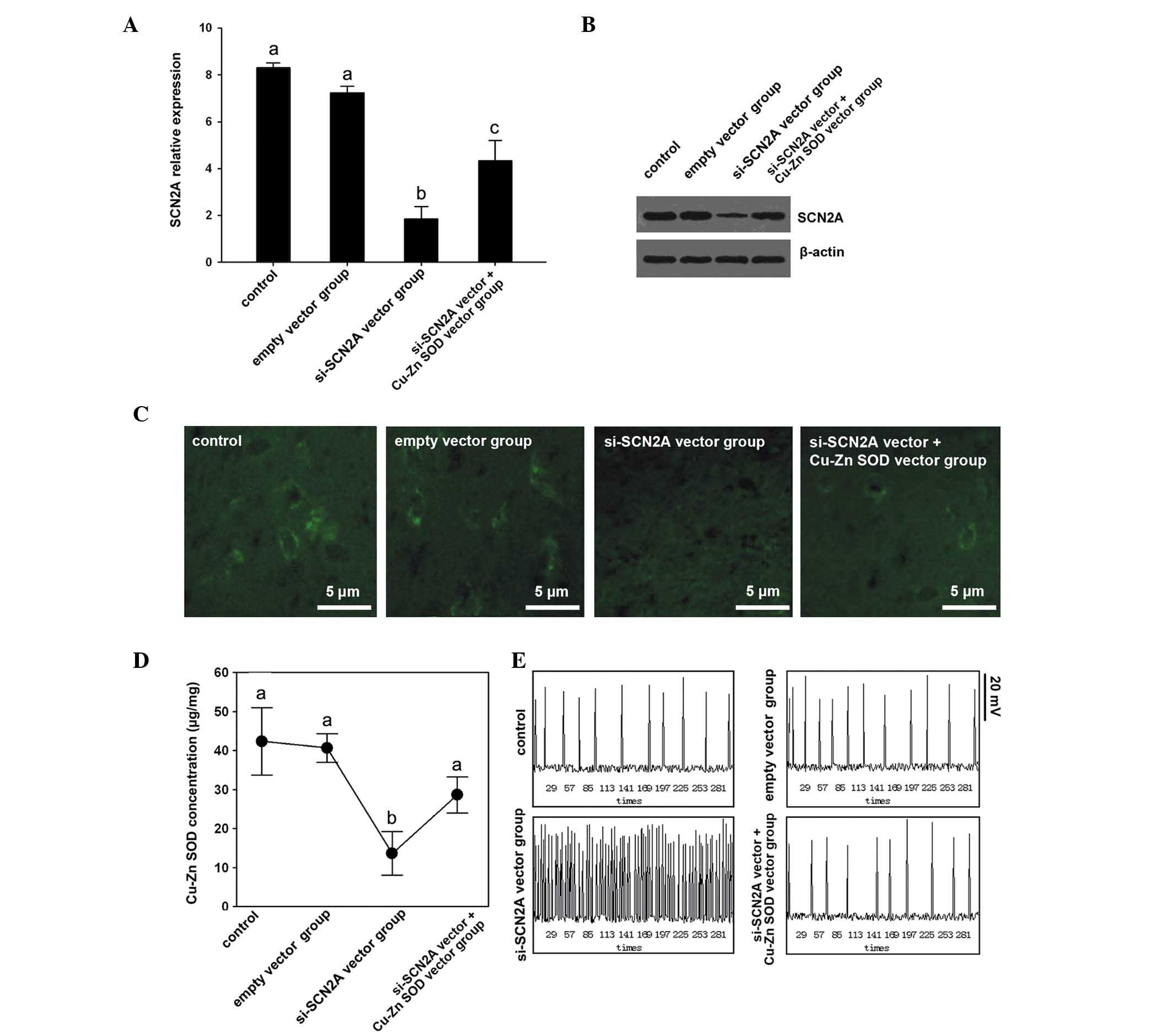|
1
|
Lakhan R, Kumari R, Misra UK, Kalita J,
Pradhan S and Mittal B: Differential role of sodium channels SCN1A
and SCN2A gene polymorphisms with epilepsy and multiple drug
resistance in the North Indian population. Br J Clin Pharmacol.
68:214–220. 2009. View Article : Google Scholar
|
|
2
|
Clary HM: Promising New Directions in
Epilepsy Management. Neurology. 21:21–25. 2012.
|
|
3
|
Estacion M, Gasser A, Dib-Hajj SD and
Waxman SG: A sodium channel mutation linked to epilepsy increases
ramp and persistent current of Nav1.3 and induces hyperexcitability
in hippocampal neurons. Exp Neurol. 224:362–368. 2010. View Article : Google Scholar : PubMed/NCBI
|
|
4
|
Liao Y, Anttonen AK, Liukkonen E, et al:
SCN2A mutation associated with neonatal epilepsy, late-onset
episodic ataxia, myoclonus, and pain. Neurology. 75:1454–1458.
2010. View Article : Google Scholar : PubMed/NCBI
|
|
5
|
Felts P, Yokoyama S, Dib-Hajj S, Black J
and Waxman SG: Sodium channel α-subunit mRNAs I, II, III, NaG, Na6
and hNE (PN1): different expression patterns in developing rat
nervous system. Brain Res Mol Brain Res. 45:71–82. 1997.
|
|
6
|
Whitaker WR, Clare JJ, Powell AJ, Chen YH,
Faull RL and Emson PC: Distribution of voltage-gated sodium channel
α-subunit and β-subunit mRNAs in human hippocampal formation,
cortex and cerebellum. J Comp Neurol. 422:123–139. 2000.
|
|
7
|
Meisler MH and Kearney JA: Sodium channel
mutations in epilepsy and other neurological disorders. J Clin
Invest. 115:2010–2017. 2005. View
Article : Google Scholar : PubMed/NCBI
|
|
8
|
Kearney JA, Plummer NW, Smith MR, et al: A
gain-of-function mutation in the sodium channel gene Scn2a results
in seizures and behavioral abnormalities. Neuroscience.
102:307–317. 2001. View Article : Google Scholar : PubMed/NCBI
|
|
9
|
Lombardo AJ, Kuzniecky R, Powers RE and
Brown GB: Altered brain sodium channel transcript levels in human
epilepsy. Brain Res Mol Brain Res. 35:84–90. 1996. View Article : Google Scholar : PubMed/NCBI
|
|
10
|
Malmström BG: Enzymology of oxygen. Annu
Rev Biochem. 51:21–59. 1982.
|
|
11
|
Dugan LL, Sensi SL, Canzoniero LM, et al:
Mitochondrial production of reactive oxygen species in cortical
neurons following exposure to N-methyl-D-aspartate. J Neurosci.
15:6377–6388. 1995.PubMed/NCBI
|
|
12
|
Forman HJ and Torres M: Redox signaling in
macrophages. Mol Aspects Med. 22:189–216. 2001. View Article : Google Scholar
|
|
13
|
Fridovich I: The biology of oxygen
radicals. Science. 201:875–880. 1978. View Article : Google Scholar : PubMed/NCBI
|
|
14
|
Sudha K, Rao AV and Rao A: Oxidative
stress and antioxidants in epilepsy. Clin Chim Acta. 303:19–24.
2001. View Article : Google Scholar : PubMed/NCBI
|
|
15
|
Mori A, Hiramatsu M, Yokoi I and Edamatsu
R: Biochemical pathogenesis of post-traumatic epilepsy. Integr
Physiol Behav Sci. 25:54–62. 1990.
|
|
16
|
Nazıroglu M: Role of selenium on calcium
signaling and oxidative stress-induced molecular pathways in
epilepsy. Neurochem Res. 34:2181–2191. 2009.PubMed/NCBI
|
|
17
|
Waldbaum S and Patel M: Mitochondria,
oxidative stress, and temporal lobe epilepsy. Epilepsy Res.
88:23–45. 2010. View Article : Google Scholar : PubMed/NCBI
|
|
18
|
Ercegovac M, Jovic N, Simic T, et al:
Byproducts of protein, lipid and DNA oxidative damage and
antioxidant enzyme activities in seizure. Seizure. 19:205–210.
2010. View Article : Google Scholar : PubMed/NCBI
|
|
19
|
Fertig N, Blick RH and Behrends JC: Whole
cell patch clamp recording performed on a planar glass chip.
Biophys J. 82:3056–3062. 2002. View Article : Google Scholar : PubMed/NCBI
|
|
20
|
Tahiliani M, Mei P, Fang R, et al: The
histone H3K4 demethylase SMCX links REST target genes to X-linked
mental retardation. Nature. 447:601–605. 2007. View Article : Google Scholar : PubMed/NCBI
|
|
21
|
Hu Y, Rosen DG, Zhou Y, et al:
Mitochondrial manganese-superoxide dismutase expression in ovarian
cancer: role in cell proliferation and response to oxidative
stress. J Biol Chem. 280:39485–39492. 2005. View Article : Google Scholar : PubMed/NCBI
|
|
22
|
Scheffer IE and Berkovic SF: The genetics
of human epilepsy. Trends Pharmacol Sci. 24:428–433. 2003.
View Article : Google Scholar : PubMed/NCBI
|
|
23
|
Michaelis EK: Molecular biology of
glutamate receptors in the central nervous system and their role in
excitotoxicity, oxidative stress and aging. Prog Neurobiol.
54:369–415. 1998. View Article : Google Scholar : PubMed/NCBI
|
|
24
|
Goldin AL: Evolution of voltage-gated
Na+channels. J Exp Biol. 205:575–584. 2002.PubMed/NCBI
|
|
25
|
Akbas SH, Yegin A and Ozben T: Effect of
pentylenetetrazol-induced epileptic seizure on the antioxidant
enzyme activities, glutathione and lipid peroxidation levels in rat
erythrocytes and liver tissues. Clin Biochem. 38:1009–1014. 2005.
View Article : Google Scholar
|
|
26
|
Ansenberger-Fricano K, Ganini DS, Mao M,
et al: The peroxidase activity of mitochondrial superoxide
dismutase. Free Radic Biol Med. 54:116–124. 2012. View Article : Google Scholar
|
|
27
|
Lobo V, Patil A, Phatak A and Chandra N:
Free radicals, antioxidants and functional foods: Impact on human
health. Pharmacogn Rev. 4:118–126. 2010. View Article : Google Scholar : PubMed/NCBI
|
|
28
|
Simonian NA and Coyle JT: Oxidative stress
in neurodegenerative diseases. Annu Rev Pharmacol Toxicol.
36:83–106. 1996. View Article : Google Scholar : PubMed/NCBI
|

















